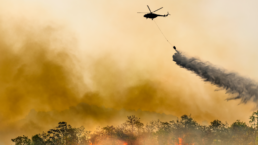Fires scorched the country in March. Is ‘wildfire season’ a thing of the past?
By Lina Tran, Grist
It’s nearly three months into 2021, and the country has already seen wildfires burning across Florida, Texas, and Colorado. Hundreds of thousands of acres have been scorched, in an unusual start to spring.
In the last week of March, gusty winds and a record-setting heat wave in the West stoked fires near Boulder, Colorado. Emergency officials ordered 19,400 people to evacuate from the NCAR fire, named for its proximity to the National Center for Atmospheric Research, known for its climate science. According to one official, the unseasonal flames signal the end of Colorado’s fire seasons as the state used to know it. “There’s no longer a fire season, is really the concern,” said Brian Oliver, an incident commander on the NCAR fire, in a media briefing on Monday. “Fire season’s year round now. Anytime there’s not snow, it’s fire.”

Unseasonal, destructive wildfires like this month’s have long raised concerns that climate change is fueling more extreme blazes in the U.S. A recent study in Science Advances reported new evidence for this “palpable change”: Using records dating back to 1984, researchers found that, on average, fires are four times larger and three times more frequent since 2000. In the East and West, fires doubled in frequency compared to the previous two decades, and in the Great Plains, they quadrupled. They’ve also exploded in size: Great Plains blazes, for instance, are six times bigger than before. And not only have fires become more common, but they’ve also crept into places that hadn’t burned before, like parts of New England. Before 2000, there were virtually no extreme fires in Arizona, New Mexico, and Texas, according to the study.
Recent Posts
‘Unconstitutional. Unethical. Authoritarian.’ ICE Bars Millions Of Immigrants From Bond Hearings
July 18, 2025
Take Action Now One watchdog said the new policy “seems like a blatant attempt to stop them from exercising their right to due process.”……
Americans Are Not Nearly Alarmed Enough About Climate Change
July 18, 2025
Take Action Now Americans still don’t comprehend how imminent, dangerous, and far-reaching the threat is—and journalists are partly to blame.By…
The IRS Is Building A Vast System To Share Millions Of Taxpayers’ Data With ICE
July 17, 2025
Take Action Now ProPublica has obtained the blueprint for the Trump administration’s unprecedented plan to turn over IRS records to Homeland Security…
Israel’s Sudden Assault On Syria Is Unchecked Aggression
July 17, 2025
Take Action Now Jerusalem is bombing Damascus and threatening al-Sharaa’s rule, while Washington was hoping to help the nascent government on…




